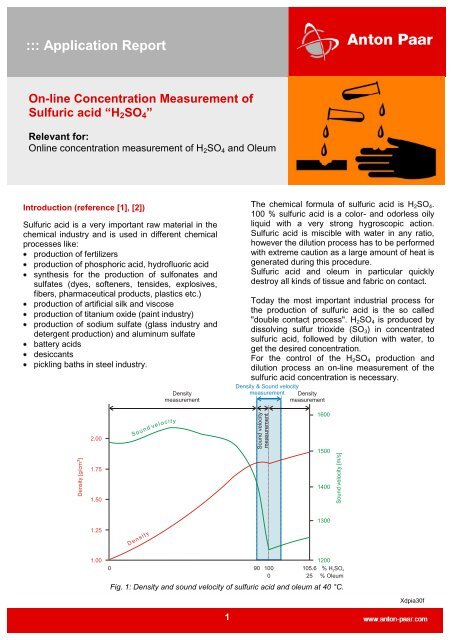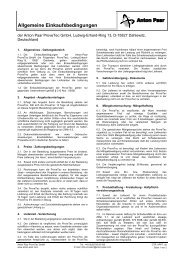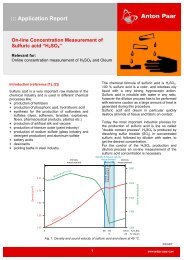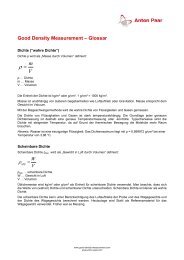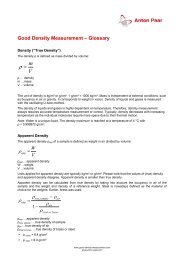On-line Concentration Measurement of Sulfuric acid - Anton Paar.com
On-line Concentration Measurement of Sulfuric acid - Anton Paar.com
On-line Concentration Measurement of Sulfuric acid - Anton Paar.com
Create successful ePaper yourself
Turn your PDF publications into a flip-book with our unique Google optimized e-Paper software.
::: Application Report<br />
<strong>On</strong>-<strong>line</strong> <strong>Concentration</strong> <strong>Measurement</strong> <strong>of</strong><br />
<strong>Sulfuric</strong> <strong>acid</strong> “H2SO4”<br />
Relevant for:<br />
<strong>On</strong><strong>line</strong> concentration measurement <strong>of</strong> H2SO4 and Oleum<br />
Introduction (reference [1], [2])<br />
<strong>Sulfuric</strong> <strong>acid</strong> is a very important raw material in the<br />
chemical industry and is used in different chemical<br />
processes like:<br />
production <strong>of</strong> fertilizers<br />
production <strong>of</strong> phosphoric <strong>acid</strong>, hydr<strong>of</strong>luoric <strong>acid</strong><br />
synthesis for the production <strong>of</strong> sulfonates and<br />
sulfates (dyes, s<strong>of</strong>teners, tensides, explosives,<br />
fibers, pharmaceutical products, plastics etc.)<br />
production <strong>of</strong> artificial silk and viscose<br />
production <strong>of</strong> titanium oxide (paint industry)<br />
production <strong>of</strong> sodium sulfate (glass industry and<br />
detergent production) and aluminum sulfate<br />
battery <strong>acid</strong>s<br />
desiccants<br />
pickling baths in steel industry.<br />
Density [g/cm ] 3<br />
2.00<br />
1.75<br />
1.50<br />
1.25<br />
1.00<br />
o<br />
S<br />
u d<br />
D e n s i t y<br />
e<br />
n v l oc i t y<br />
Density<br />
measurement<br />
1<br />
The chemical formula <strong>of</strong> sulfuric <strong>acid</strong> is H2SO4.<br />
100 % sulfuric <strong>acid</strong> is a color- and odorless oily<br />
liquid with a very strong hygroscopic action.<br />
<strong>Sulfuric</strong> <strong>acid</strong> is miscible with water in any ratio,<br />
however the dilution process has to be performed<br />
with extreme caution as a large amount <strong>of</strong> heat is<br />
generated during this procedure.<br />
<strong>Sulfuric</strong> <strong>acid</strong> and oleum in particular quickly<br />
destroy all kinds <strong>of</strong> tissue and fabric on contact.<br />
Today the most important industrial process for<br />
the production <strong>of</strong> sulfuric <strong>acid</strong> is the so called<br />
"double contact process". H2SO4 is produced by<br />
dissolving sulfur trioxide (SO3) in concentrated<br />
sulfuric <strong>acid</strong>, followed by dilution with water, to<br />
get the desired concentration.<br />
For the control <strong>of</strong> the H2SO4 production and<br />
dilution process an on-<strong>line</strong> measurement <strong>of</strong> the<br />
sulfuric <strong>acid</strong> concentration is necessary.<br />
Density & Sound velocity<br />
measurement Density<br />
measurement<br />
Sound velocity<br />
measurement<br />
1600<br />
1500<br />
1400<br />
1300<br />
0 90 100<br />
105.6<br />
1200<br />
% H2SO4 0 25 % Oleum<br />
Fig. 1: Density and sound velocity <strong>of</strong> sulfuric <strong>acid</strong> and oleum at 40 °C.<br />
Sound velocity [m/s]<br />
Xdpia30f
::: Application Report<br />
<strong>On</strong>-<strong>line</strong> <strong>Concentration</strong> <strong>Measurement</strong> <strong>of</strong><br />
<strong>Sulfuric</strong> <strong>acid</strong> “H2SO4”<br />
Relevant for:<br />
<strong>On</strong><strong>line</strong> concentration measurement <strong>of</strong> H2SO4 and Oleum<br />
<strong>Concentration</strong> determination <strong>of</strong> sulfuric <strong>acid</strong><br />
The concentration <strong>of</strong> aqueous solutions <strong>of</strong> sulfuric<br />
<strong>acid</strong> is quoted as % w/w H2SO4.<br />
Figure 1 shows the density/concentration and sound<br />
velocity/concentration relationship for sulfuric <strong>acid</strong> at<br />
40°C.<br />
The concentration <strong>of</strong> oleum <strong>of</strong> different strength is<br />
quoted according to the content <strong>of</strong> "free SO3" in<br />
100 % sulfuric <strong>acid</strong>; thus oleum-40 contains 40 % <strong>of</strong><br />
free SO3 in 100 % sulfuric <strong>acid</strong> (this corresponds to<br />
an equivalent concentration <strong>of</strong> 109 % H2SO4 as the<br />
result <strong>of</strong> a titration).<br />
% free SO3<br />
0<br />
10<br />
20<br />
30<br />
40<br />
50<br />
60<br />
70<br />
Equivalent %<br />
H2SO4<br />
100.00<br />
102.25<br />
104.50<br />
106.75<br />
109.00<br />
111.25<br />
113.50<br />
115.75<br />
To achieve highest accuracy, the physical property<br />
(density or sound velocity) which shows the biggest<br />
change upon change in sulfuric <strong>acid</strong> concentration<br />
should be employed for the determination <strong>of</strong><br />
% H2SO4.<br />
0-90 % w/w<br />
Density measurement should be used to calculate<br />
H2SO4 concentration from 0 to 90 % w/w, because<br />
density has a steep and almost <strong>line</strong>ar dependence<br />
on the <strong>acid</strong> concentration.<br />
2<br />
90-100 % w/w<br />
Sound velocity should be used to determine the<br />
H2SO4 concentration in the range <strong>of</strong> 90 to 100 %<br />
w/w, since it is strongly influenced by a<br />
concentration change whereas density changes<br />
only very little in this range.<br />
0-25 % w/w oleum<br />
In the oleum range from 0 to 25 % free SO3,<br />
density measurement should be utilized again to<br />
calculate the H2SO4 concentration.<br />
90-110 % w/w<br />
To measure over the 100 % concentration, a<br />
density and sound velocity signal is needed. <strong>On</strong>ly<br />
by <strong>com</strong>bination <strong>of</strong> 2 physical independent signals<br />
this measurement range is possible!<br />
Typical installation sites<br />
Double contact process<br />
The starting material for the production <strong>of</strong> sulfuric<br />
<strong>acid</strong> is sulfur dioxide (SO2), which is produced by<br />
<strong>com</strong>bustion <strong>of</strong> sulfur or roasting <strong>of</strong> sulfur<br />
containing ores.<br />
Sulfur dioxide is reacted with oxygen (oxidized)<br />
to give sulfur trioxide. This reaction occurs at four<br />
to five vanadium oxide contacts. After the third<br />
contact most <strong>of</strong> the formed SO3 is removed from<br />
the reaction mixture and fed into the first<br />
absorber. The residual reaction <strong>com</strong>ponents<br />
(SO2 and O2) are again reacted at the vanadium<br />
oxide contacts. The formed SO3 is fed into the<br />
second absorber.
::: Application Report<br />
<strong>On</strong>-<strong>line</strong> <strong>Concentration</strong> <strong>Measurement</strong> <strong>of</strong><br />
<strong>Sulfuric</strong> <strong>acid</strong> “H2SO4”<br />
Relevant for:<br />
<strong>On</strong><strong>line</strong> concentration measurement <strong>of</strong> H2SO4 and Oleum<br />
Fig. 2: Simplified scheme <strong>of</strong> the "double contact process"<br />
In the "double contact process" a total SO2<br />
conversion <strong>of</strong> 99.6 to 99.7 % is reached.<br />
In the intermediate and final absorbers sulfur<br />
trioxide is dissolved in 98 % to 100 % sulfuric <strong>acid</strong> to<br />
give fuming sulfuric <strong>acid</strong> or oleum (fuming: escaping<br />
sulfur trioxide forms fumes <strong>of</strong> sulfuric <strong>acid</strong> with<br />
atmospheric humidity).<br />
The oleum or concentrated sulfuric <strong>acid</strong> is diluted to<br />
the desired concentration.<br />
3
::: Application Report<br />
<strong>On</strong>-<strong>line</strong> <strong>Concentration</strong> <strong>Measurement</strong> <strong>of</strong><br />
<strong>Sulfuric</strong> <strong>acid</strong> “H2SO4”<br />
Relevant for:<br />
<strong>On</strong><strong>line</strong> concentration measurement <strong>of</strong> H2SO4 and Oleum<br />
Installation<br />
Depending on the requirements the density<br />
and/or sound velocity transducers can be<br />
installed at different sites in the process.<br />
0-90 % w/w<br />
For this application the DPRn sensor must be<br />
made <strong>of</strong> tantalum which shows an excellent<br />
resistance against sulfuric <strong>acid</strong> between 0-75 °C.<br />
For the measurement <strong>of</strong> oleum the DPRn<br />
transducer must be made <strong>of</strong> glass.<br />
DPRn<br />
Fig. 3: Bypass installation <strong>of</strong> the DPRn<br />
mPDS 1100<br />
TEMP+16.14 : °C<br />
PER-D: 2574.976 us<br />
DENS: 1.33317 g/cm3<br />
Ai-curr: 0.160 mA<br />
L<br />
06<br />
ESC<br />
ENTER<br />
mPDS 1100<br />
90-100 % w/w<br />
For H2SO4 concentration in the range <strong>of</strong> 90 to<br />
100 % w/w a gold plated SPRn sound velocity<br />
transducer is used. The gold plated SPRn<br />
transducer is inserted into the <strong>line</strong> using standard<br />
fittings (DIN 2633, DN40 PN16). All wetted parts <strong>of</strong><br />
the transducer are gold plated to prevent corrosion<br />
<strong>of</strong> the transducer material by sulfuric <strong>acid</strong>.<br />
4<br />
SPRn<br />
TEMP+16.14 : °C<br />
Fig. 4: In-<strong>line</strong> installation <strong>of</strong> the SPRn<br />
PER-D: 2574.976 us<br />
DENS: 1.33317 g/cm3<br />
Ai-curr: 0.160 mA<br />
L<br />
06<br />
ESC<br />
ENTER<br />
mPDS 1100<br />
Density or sound velocity and temperature are<br />
transferred to the mPDS 1100 by a two wire cable.<br />
The same cable powers the transducer and it can<br />
be <strong>of</strong> almost any length.<br />
90-110 %w/w<br />
For the measurement range over 100 % the DSRn<br />
sensor which delivers density, sound velocity and<br />
temperature is needed. As evaluation unit the<br />
mPDS 5 have to be connected. Because the<br />
DSRn is only available in Hastelloy the maximum<br />
temperature must not exceed 40 °C!<br />
DSRn<br />
Fig. 5: Bypass installation <strong>of</strong> the DSRn<br />
mPDS 1100
::: Application Report<br />
<strong>On</strong>-<strong>line</strong> <strong>Concentration</strong> <strong>Measurement</strong> <strong>of</strong><br />
<strong>Sulfuric</strong> <strong>acid</strong> “H2SO4”<br />
Relevant for:<br />
<strong>On</strong><strong>line</strong> concentration measurement <strong>of</strong> H2SO4 and Oleum<br />
Measuring range<br />
DPRn transducer:<br />
Temperature: 0 to 100 °C<br />
<strong>Concentration</strong>: 0 to 90 % w/w H2SO4<br />
(DPRn 427 Tantalum cell required)<br />
0 to 25 % oleum<br />
(DPRn 407, glass cell required)<br />
SPRn transducer:<br />
Temperature: 20 to 90 °C<br />
<strong>Concentration</strong>: 90 to 100 % w/w H2SO4<br />
(SPRn 4115 Gold cell required)<br />
DSRn transducer:<br />
Temperature: 20 to 40 °C<br />
<strong>Concentration</strong>: 90 to 110 % w/w H2SO4<br />
(DSRn 427 Hastelloy cell required)<br />
Measuring results - accuracy<br />
Following parameters influence the measuring<br />
result:<br />
Density accuracy: 1 x 10 -4 g/cm 3<br />
Corresponding variations in H2SO4<br />
concentration: 0.05 % w/w H2SO4 or oleum<br />
(typical)<br />
Sound velocity accuracy: 0.1 m/s<br />
Corresponding variations in H2SO4<br />
concentration: 0.05 % w/w H2SO4 (typical).<br />
Temperature influences are <strong>com</strong>pensated by<br />
the built-in temperature measurement.<br />
Total error:<br />
Variations <strong>of</strong> all process conditions occurring in<br />
practice lead to a total error <strong>of</strong> 0.1 % w/w H2SO4.<br />
5<br />
Benefits<br />
90-110 % continuous measurement!<br />
<strong>Anton</strong> <strong>Paar</strong> on-<strong>line</strong> transducers guarantee<br />
highly accurate density and sound velocity<br />
measurement <strong>of</strong> H2SO4 and oleum.<br />
The concentration <strong>of</strong> H2SO4 and oleum is<br />
determined over a wide concentration<br />
range.<br />
DPRn, SPRn and DSRn transducers allow<br />
measurements to be automatically converted<br />
into % H2SO4 by the mPDS 5 evaluation unit.<br />
H2SO4 quality is continuously assured during<br />
the production process.<br />
<strong>Anton</strong> <strong>Paar</strong> sound velocity transducers <strong>of</strong>fer<br />
the possibility to measure in the concentration<br />
range <strong>of</strong> 90 to 100 % w/w H2SO4 which is <strong>of</strong><br />
particular interest during the production<br />
process.<br />
In contrast conductivity measurement cannot<br />
be used to determine % w/w H2SO4 in this<br />
concentration range.<br />
During the dilution process <strong>of</strong> concentrated<br />
H2SO4 or oleum the H2SO4 concentration can<br />
be monitored and the production yield can be<br />
improved.<br />
<strong>Anton</strong> <strong>Paar</strong> on-<strong>line</strong> transducers are successfully<br />
used at:<br />
DONAU-CHEMIE AG, Austria<br />
CU-CHEMIE UETIKON; Switzerland<br />
HAYS CHEMICALS, United Kingdom<br />
BORREGAARD INDUSTRIES Ltd., Norway<br />
and many others.
::: Application Report<br />
<strong>On</strong>-<strong>line</strong> <strong>Concentration</strong> <strong>Measurement</strong> <strong>of</strong><br />
<strong>Sulfuric</strong> <strong>acid</strong> “H2SO4”<br />
Relevant for:<br />
<strong>On</strong><strong>line</strong> concentration measurement <strong>of</strong> H2SO4 and Oleum<br />
Summary<br />
<strong>On</strong>-<strong>line</strong> density and sound velocity<br />
measurements provide accurate % w/w H2SO4<br />
determination at important stages <strong>of</strong> the<br />
production process <strong>of</strong> sulfuric <strong>acid</strong>.<br />
The applied measuring methods are simple, rigid<br />
and accurate.<br />
The DSA 5000 M <strong>Sulfuric</strong> Acid Analyzer is a<br />
laboratory instrument that measures density and<br />
sound velocity simultaneously. Depending on the<br />
concentration range the density or sound velocity<br />
result is employed for the determination <strong>of</strong> % w/w<br />
H2SO4.<br />
<strong>Anton</strong> <strong>Paar</strong> on-<strong>line</strong> transducers DPRn, SPRn and<br />
DSRn <strong>of</strong>fer the possibility <strong>of</strong> an accurate<br />
concentration determination <strong>of</strong> H2SO4 and oleum<br />
for process control.<br />
References<br />
[ 1 ] Chem. unserer Zeit, 1982, 16, 149-159<br />
[ 1 ] Ullmann's Encyclopedia <strong>of</strong> Industrial<br />
Chemistry, (4.), 21, 117-166<br />
[ 1 ] Römpp Chemielexikon, Georg Thieme<br />
Verlag, 9.Auflage, 1989<br />
6


